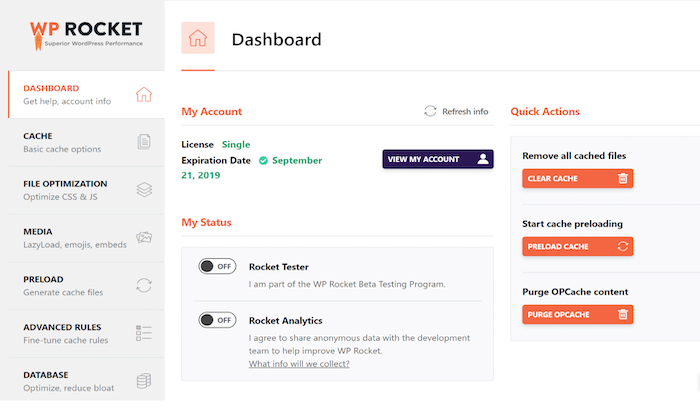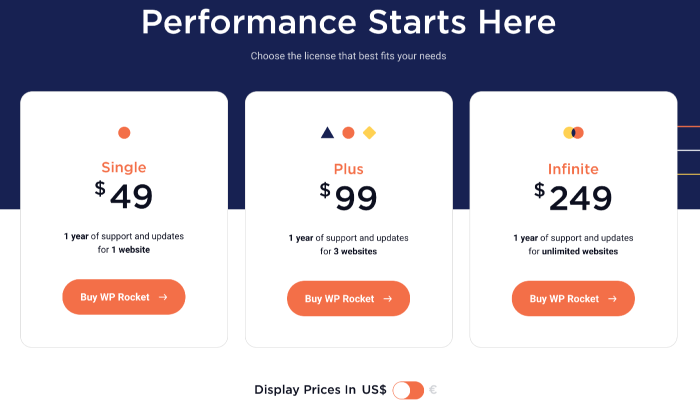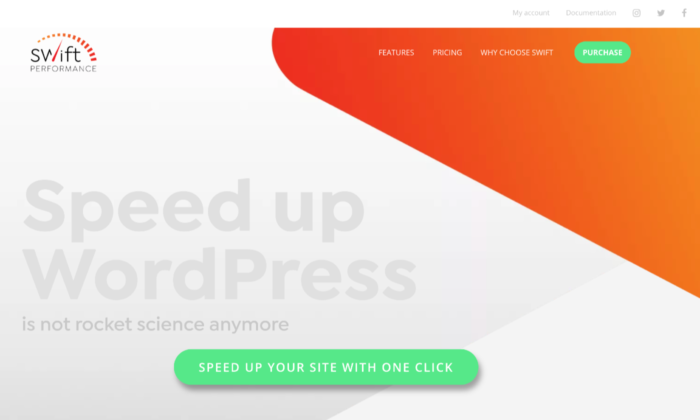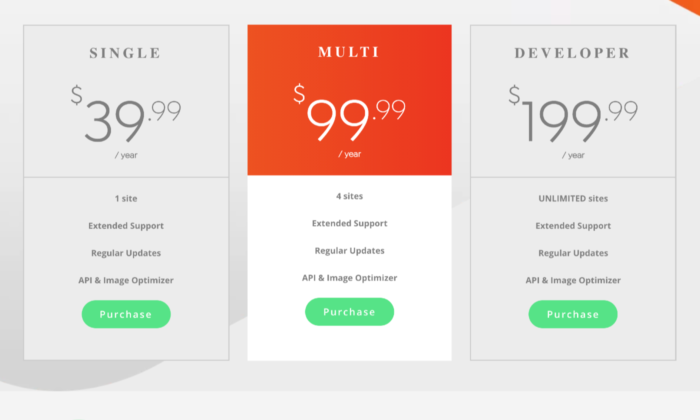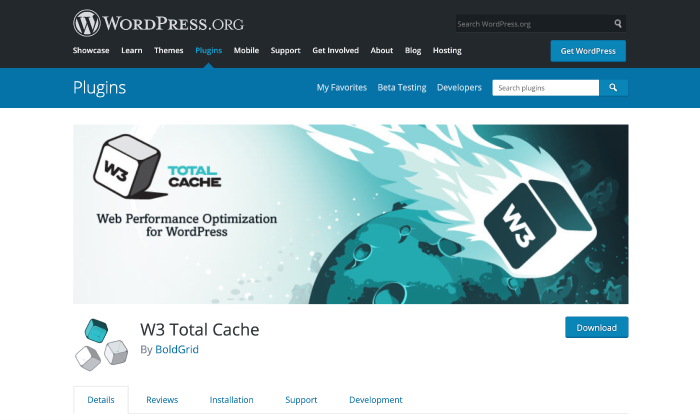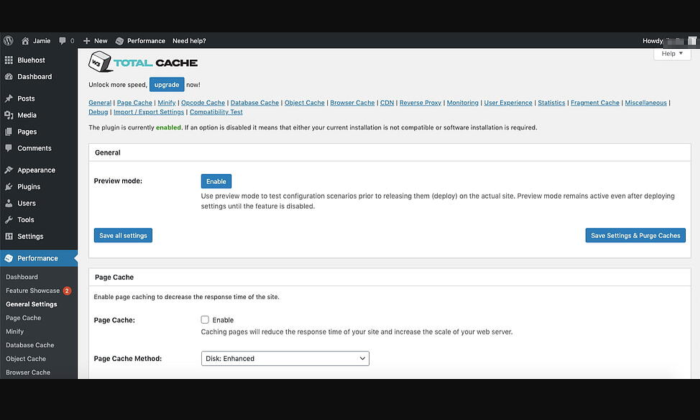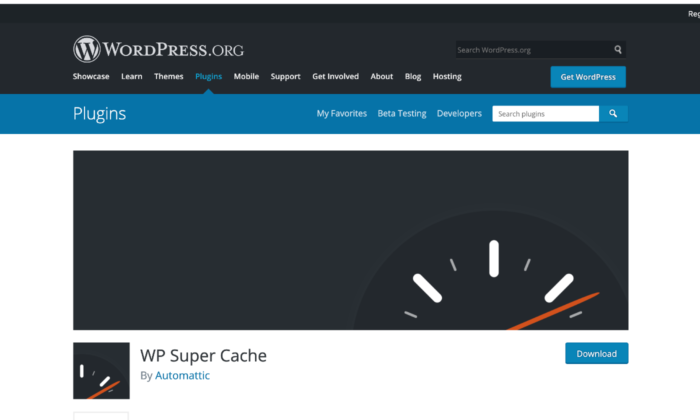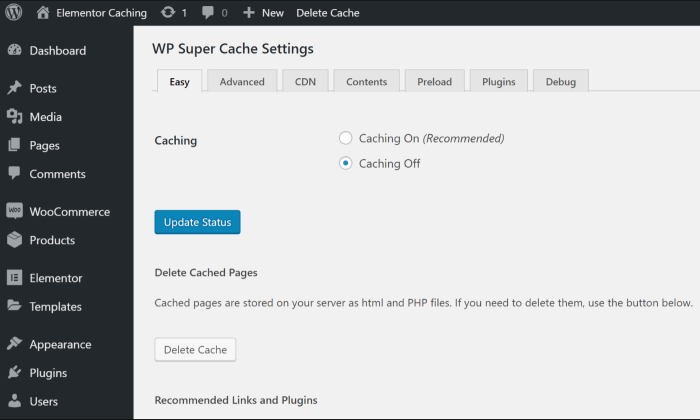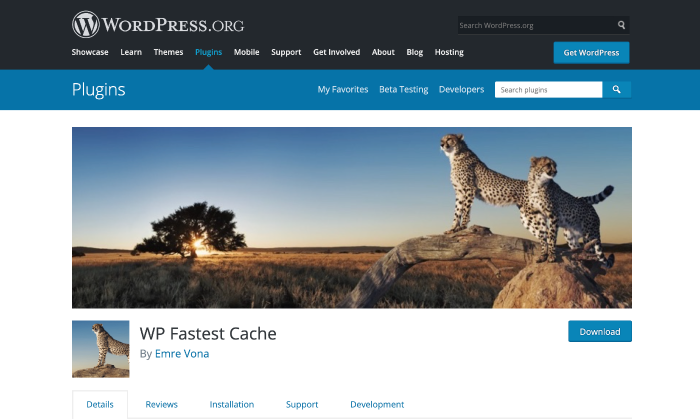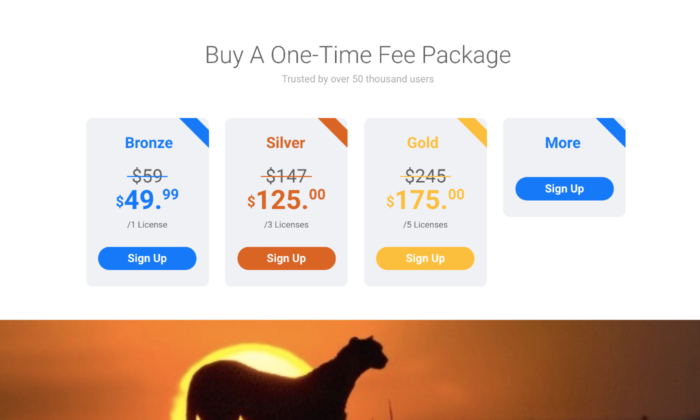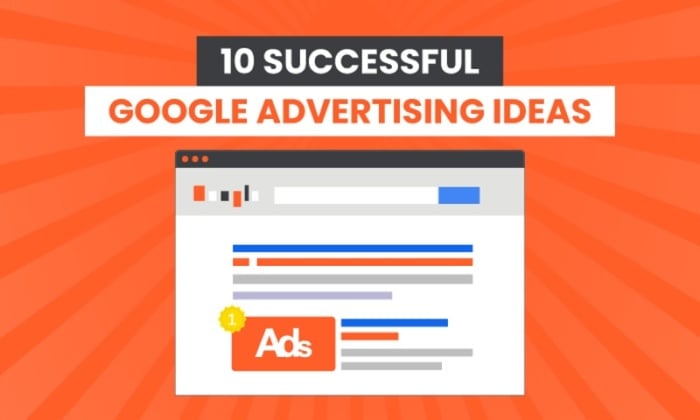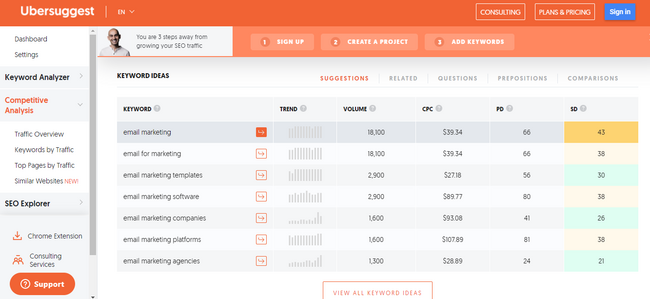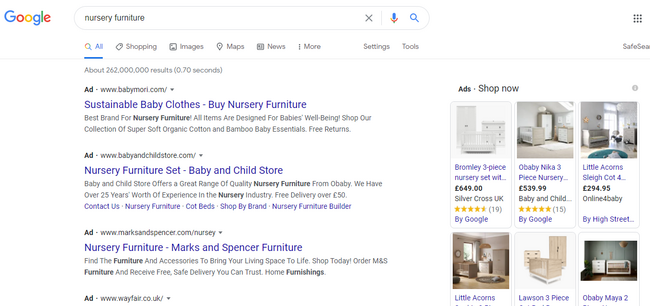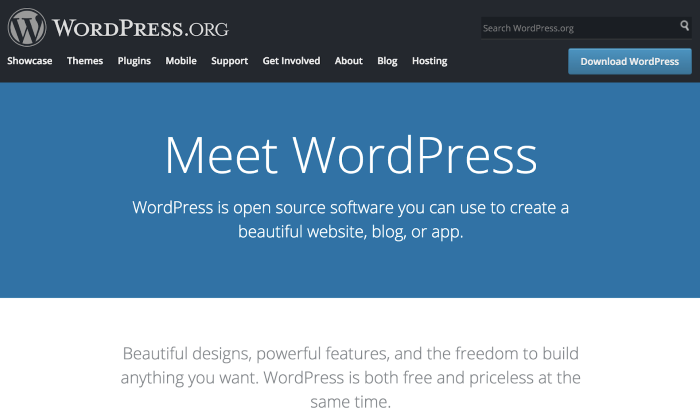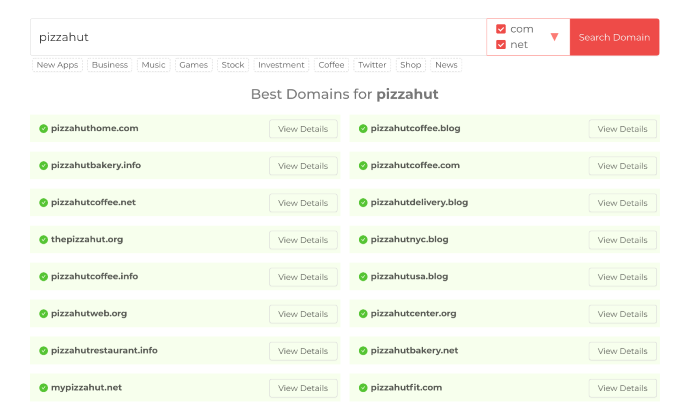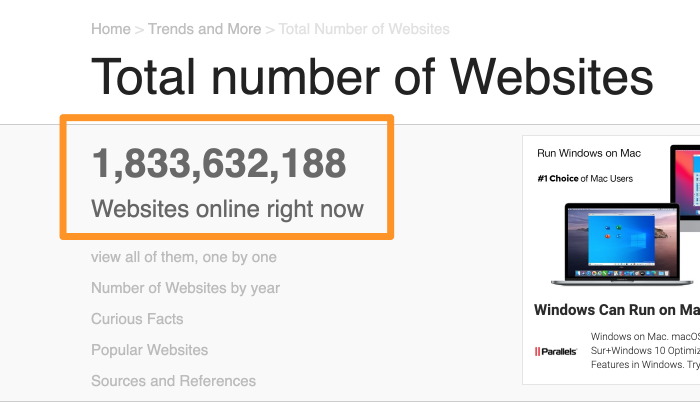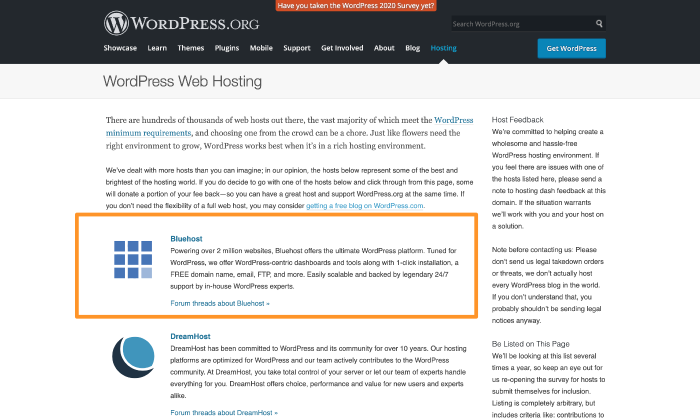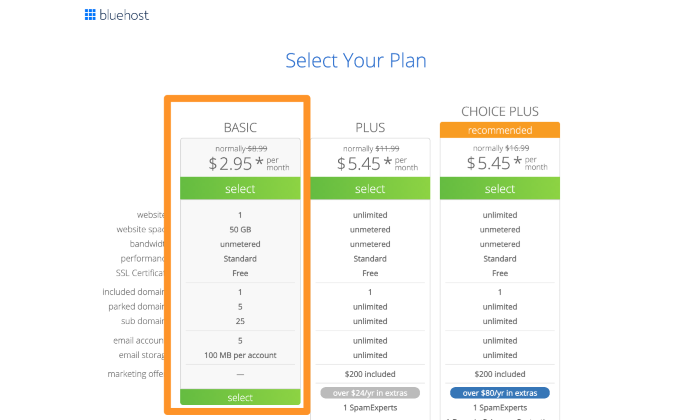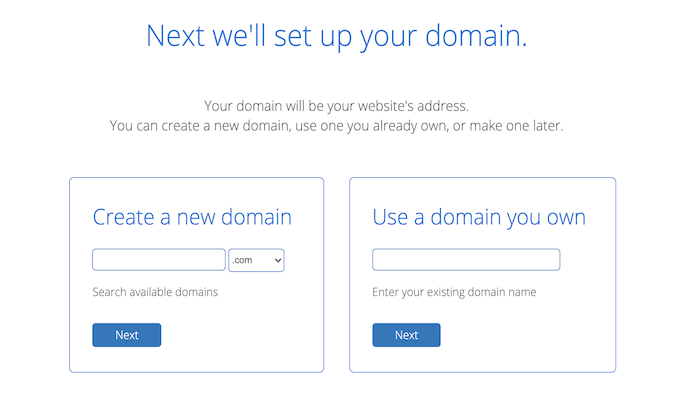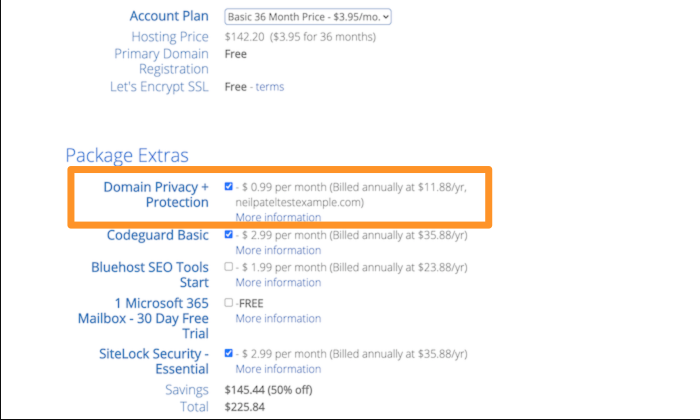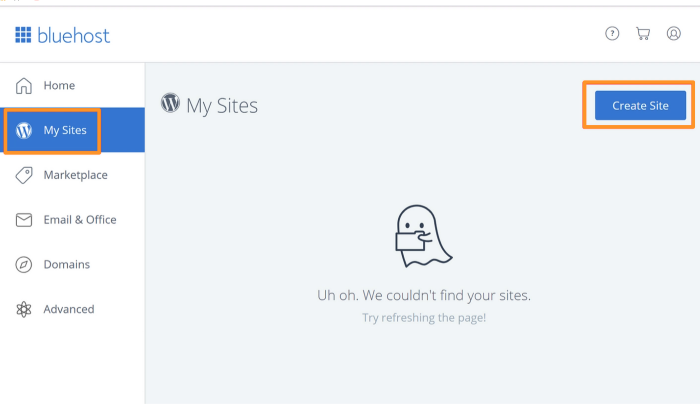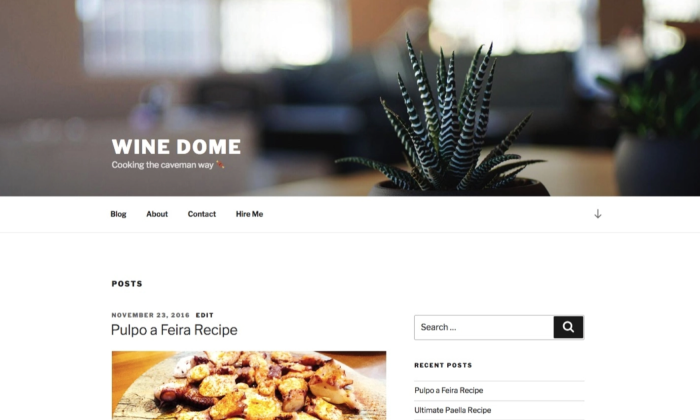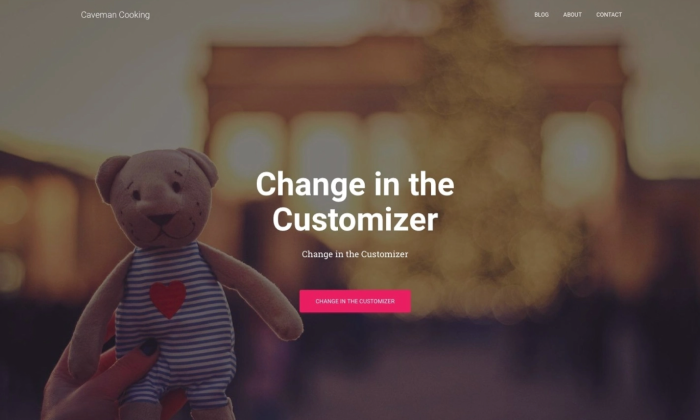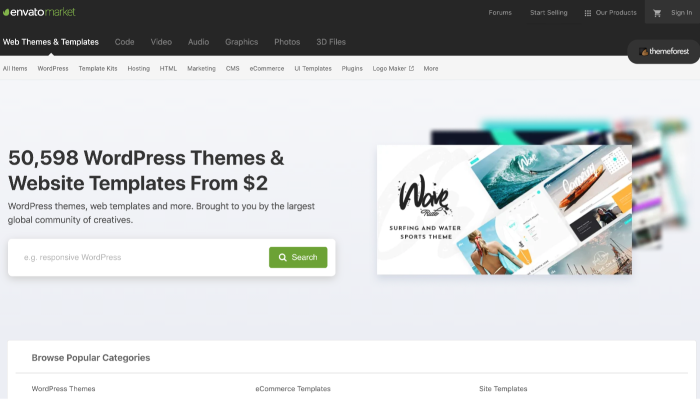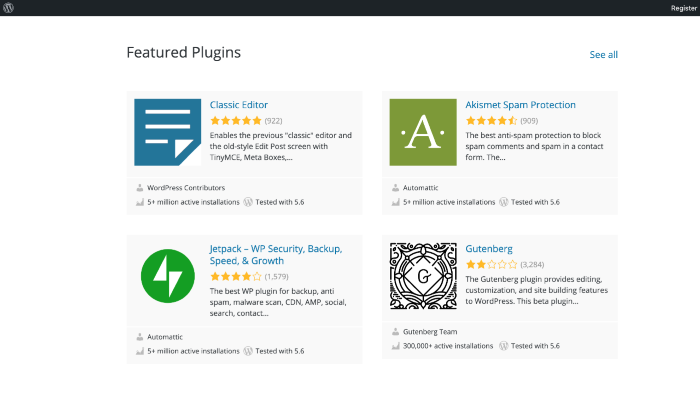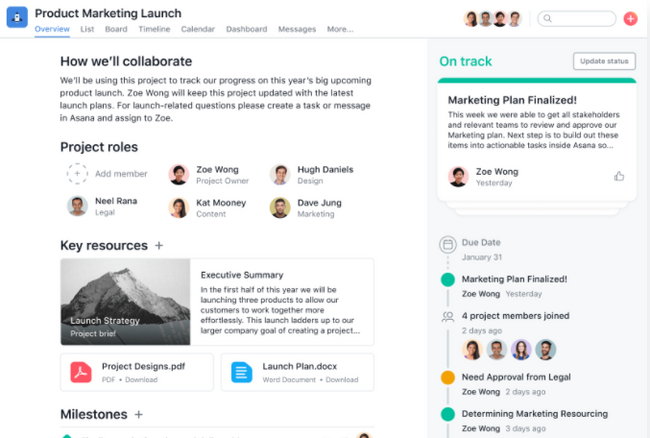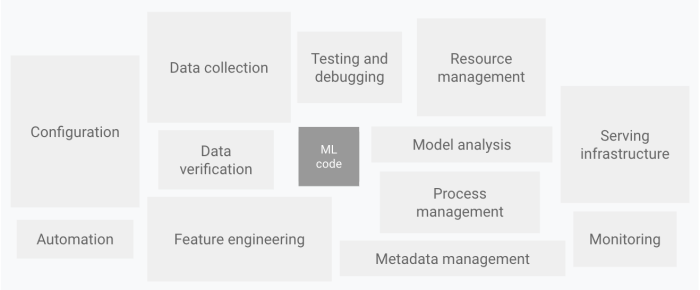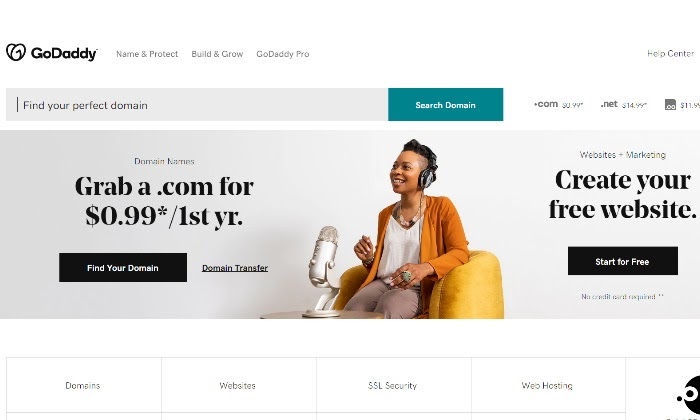
Disclosure: This content is reader-supported, which means if you click on some of our links that we may earn a commission.
GoDaddy hosts millions of websites all over the world as a giant in the hosting and domain name selling game. Its long list of products offers just about anything you might need to get a website up and running on a shoestring budget, at least for the first year.
After lots of research, comparison, and consideration, it’s safe to say GoDaddy satisfies most of your website needs, especially if it’s your first time building a site and you want affordable VPS hosting.
Beyond that, and as with any other web hosting and domain name provider, there are solid pros and cons to its plans and packages.
GoDaddy Compared to The Best Cheap Web Hosting
I curated a top list of affordable web hosting providers, so you know your options if you need to start a website on a budget. GoDaddy is one of the best choices if you want hosting that’s a step above shared hosting with its affordable VPS hosting plan. For the price that some hosting providers would charge for shared hosting, you can get VPS hosting through GoDaddy.
But, if you’re trying to find a more robust web hosting solution for your web project, GoDaddy does start to get expensive quickly. That’s why I deem it a great option for starter sites that can do with either shared or dedicated hosting and that don’t need tons of server power to run well.
You don’t have to make a hosting decision in a hurry, though. See all of my top picks to make a more informed decision.
Who is GoDaddy Best For?
GoDaddy is great for beginner website owners that want an affordable and convenient start for their websites with generous storage. GoDaddy also does well with around-the-clock site security monitoring, but perks like SSL certificates are add-ons you’ll have to purchase as extras.
This is why it’s a great hosting option for smaller and beginner websites working with a budget and don’t need too many robust website solutions.
GoDaddy: The Pros and Cons
There’s no question GoDaddy is one of the biggest names out there as far as how recognizable it is. It also houses the most domains globally, with over 17 million domain names on its roster.
Still, there are pros and cons to choosing GoDaddy as your web hosting provider. Here are the more prominent ones to take into account.
Pros
24/7 support: GoDaddy ensures it’s always within reach if you ever need a hand or run into trouble with your site. You can either reach them by phone or use its handy chat support option.
Lots of storage: When you look through and compare GoDaddy’s hosting plans, it’s generous with its unmetered bandwidth feature for all tiers.
Affordable .com domain: GoDaddy offers you the chance to snag a domain for only 99 cents for the first year, which can save you money as you begin.
Unlimited site hosting: Most GoDaddy plans let you host an unlimited number of websites except for its cheapest Economy plan.
Convenience: Since you can manage your domain and website in one place, GoDaddy offers convenience in managing both from one dashboard.
Cons
Constant upsells: GoDaddy is notorious when it comes to its upsells through every step of the checkout process. While it does honor the prices for each tier if that’s all you’re going for, it’s quick to suggest add-ons and extra features you might not need.
Expensive renewal rate: This is one of the reasons why I think GoDaddy is great for beginner sites that just want to get their foot in the door with hosting. Once that initial year is up, GoDaddy’s renewal rates can start to get costly for what you get.
Charges for add-ons: Other hosting providers throw in free first-year domain registration, for example, or include free SSL certification as part of its plans. GoDaddy does not always include these features depending on the plan you choose and can charge extra for them.
Inconsistent customer support: Support for GoDaddy isn’t always top-notch as convenience and reliability are concerned. There is always the possibility of long wait times to be connected to the right person.
GoDaddy Pricing
GoDaddy’s prices can be broken down into two main categories: Domain name purchases and hosting plans.
Domain Names
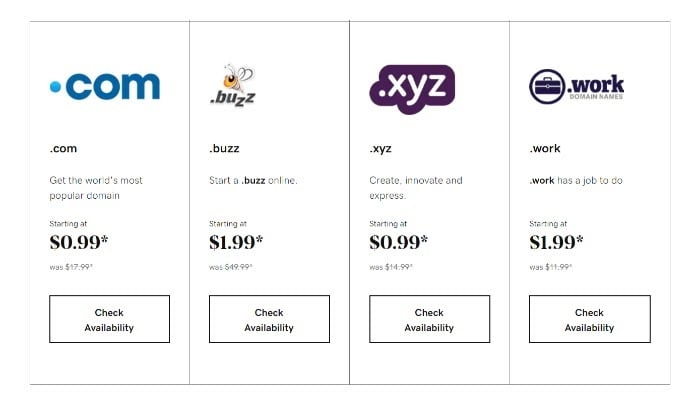
One of GoDaddy’s strengths is its huge list of domain name extensions. Its cheapest .com option, which is also one of the most popular extensions, is affordable for only 99 cents for the first year.
If you happen to choose a hosting plan that doesn’t include a free domain name, a 99-cent .com extension isn’t a terrible price to pay.
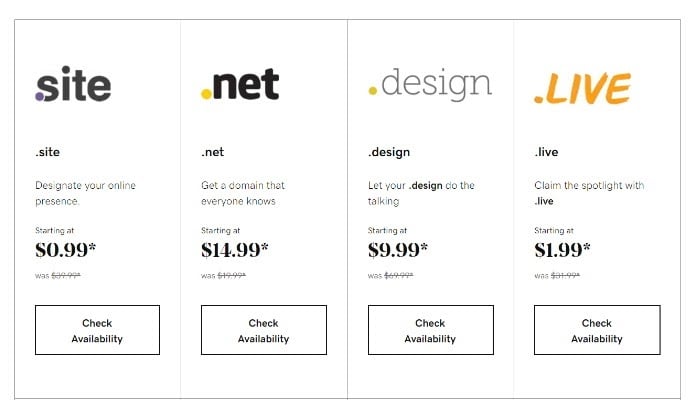
GoDaddy makes it easy to create, search for, or check on your domain name’s availability. GoDaddy offers some of the most affordable domain name plans out there as far as introductory pricing goes.
Hosting Plans
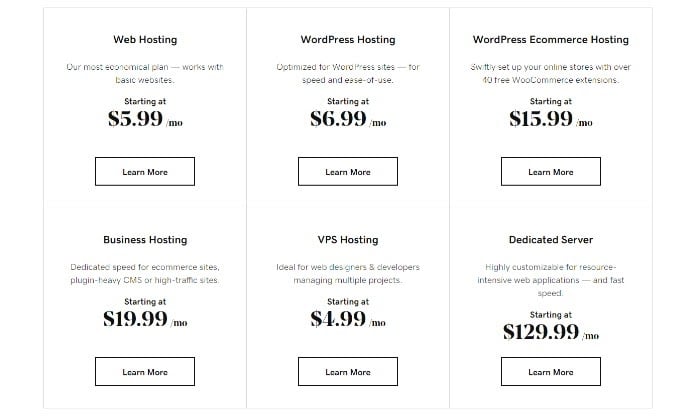
Here’s a closer look at each of GoDaddy’s hosting plans:
Web Hosting
- Economy – $5.99 a month
- Deluxe – $7.99 a month
- Ultimate – $12.99 a month
- Maximum – $19.99 a month
WordPress Hosting
- Basic – $6.99 a month
- Deluxe – $9.99 a month
- Ultimate – $12.99 a month
- Ecommerce – $15.99 a month
WordPress Ecommerce Hosting – Starting at $15.99 a month
Business Hosting
- Shared Hosting – $5.99 a month
- Business Hosting – $19.99 a month
- VPS Hosting – $4.99 a month
VPS Hosting
- 1 vCPU – $4.99 a month
- 2 vCPU – $19.99 a month
- 4 vCPU – $39.99 a month
- 8 v CPU – $69.99 a month
Dedicated Server
- DS 32 – $129.99 a month
- DS 64 – $169.99 a month
- DS 128 – $299.99 a month
- DS 256 – $399.99 a month
Windows Hosting – Starting at $5.99 a month
- Economy – $5.99
- Deluxe – $7.99
- Ultimate – $12.99
Reseller Hosting – Starting at $39.99 a month
- Enhanced – $39.99
- Grow – $49.99
- Expand – $64.99
- Established – $89.99
It’s safe to say GoDaddy offers a ton of hosting plans that cover anything you might need. A giant list of 27 different hosting plans leaves little to be desired.
I highly recommend you spend the time carefully walking through each hosting option and its corresponding tier according to your site’s needs.
If you know you’re going to be using WordPress as your CMS, then you’ll want to pay special attention to its WordPress solutions. They’re geared for SEO compatibility, speed, and ease of use once you sign up for a hosting account.
I’d like to highlight GoDaddy’s VPS hosting plan, as it’s one of the most affordable on the market. Other big-name hosting providers don’t even come close to how affordable GoDaddy’s VPS hosting plans are. You can’t beat a $4.99 price point for a self-managed virtual private server plan.
GoDaddy Offerings
GoDaddy hasn’t gotten as big as it has without offering an extensive list of website building and hosting options. Once you land on the homepage, it can be overwhelming and hard to know where to start.
To simplify its long list of plans and tools, there are three main categories its product offerings fall under. Let’s take a closer look at each one and how they stack up.
GoDaddy Name & Protect
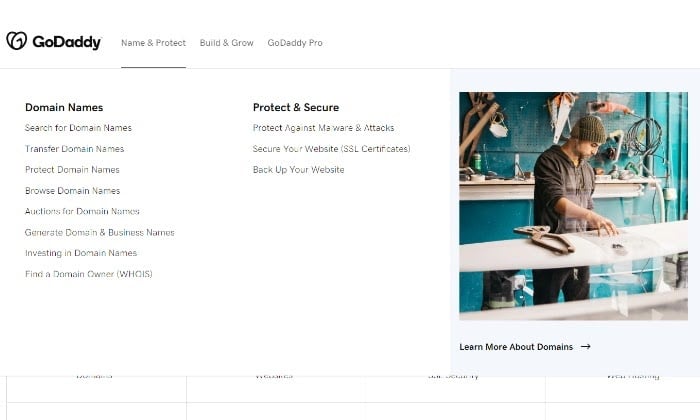
GoDaddy Name & Protect offers some useful domain tools:
- Domain name transfers
- Domain name generator
- Domain name search and WHOIS tools
- SSL Certification
- Website backup tools
- Protect against malware and site attacks
If you’re starting a website, you know you’ll need a domain name, and this is where GoDaddy shines. It’s the biggest repository of domain names, and it’s sure to have the domain name you’re looking for.
If you happen to want a domain name that’s taken, you can try out its domain brokerage services or try the domain name generator to come up with a new site name.
Like any other reputable hosting provider, GoDaddy also offers SSL certification, website backup tools, and your standard protection against malicious cyber attacks.
Because GoDaddy offers plenty of usable domain tools, it’s frequently rated as one of the most popular hosting providers out there.
But the fun doesn’t stop there. GoDaddy also offers plenty of website building and growth tools.
Go Daddy Build & Grow
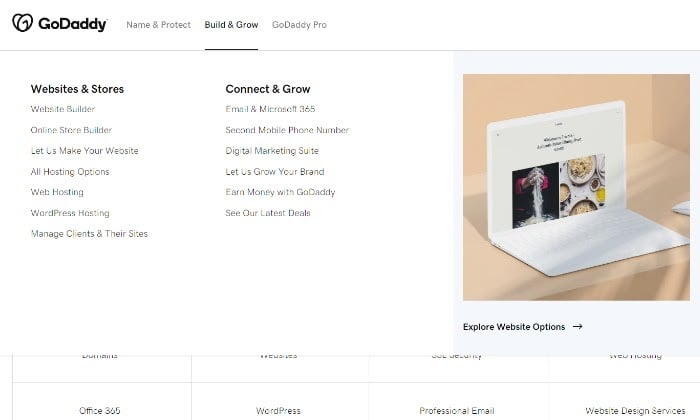
GoDaddy’s Build & Grow product offerings include:
- Website builder
- Online store builder for ecommerce sites
- An extensive array of hosting options
- Email and Microsoft 365 tools
- Second mobile phone number
- Digital marketing suite
- GoDaddy marketing services
If I were to list every single tool GoDaddy offered its customers, we’d be here forever. As a web host and domain name registrar, GoDaddy seems to have taken the route of going wide instead of going deep with its key features and offerings.
This can either appeal to you as a customer or turn you off and onto other hosting providers. It all comes down to what you value in a web host and what you’re willing to invest or need to manage your site successfully.
The most important feature in GoDaddy’s Build & Grow product offering is its buffet of web hosting options. Here’s a more in-depth look at each.
Web Hosting: GoDaddy’s most basic hosting plan starts at $5.99 a month. Not quite as cheap as other beginner-friendly hosts, but still considerably affordable and great for starter sites that want to build their online presence.
WordPress Hosting: WordPress hosting is specifically optimized for WordPress users in terms of speed and accessibility. WordPress plans start at $6.99 for basic hosting perks, including 30 GB of storage along with a free domain, free business email, and free SSL certificate. This plan works for you if your site hoovers around the 25,000 visitor mark. With three additional WordPress tiers, the deal only gets sweeter the more you pay per month.
WordPress Ecommerce Hosting: GoDaddy has solutions for ecommerce hosting as well, with plans starting at $15.99 a month along with free WooCommerce extensions. Once you sign up to one of its WooCommerce tiers, you’ll easily be able to download and install WordPress and WooCommerce together to get up and running in no time.
Business Hosting: A business hosting plan comes with more dedicated resources, but with a simplified control panel, so you don’t need a full IT team to manage your site. Plans start at $5.99 a month for shared hosting, which you can eventually upgrade as your site grows.
VPS Hosting: GoDaddy’s self-managed virtual private hosting plan is definitely one of its redeeming offers because of how affordable it is for developers and system administrators that want a more hands-on approach to their websites with plenty of customizable options. Plans start at just $4.99 a month, and it comes with one CPU Core, one GB RAM, and 100 GB SSD Storage. This is a steal when compared to what other websites charge for similar VPS hosting packages.
Windows Hosting: Yet another solid GoDaddy option for Windows fans that starts at just $5.99 a month and comes with a free domain, 100 GB of storage, and a free Office365 email for your first year. If you’re already using Windows products, this can be a great plan to integrate into what’s already working.
Reseller Hosting: Are you a reseller looking for reliable hosting resale options? GoDaddy lets you use its servers to build your own hosting business, starting at just $39.99 a month. If you’re in a unique position where you need more hosting options, you’ll have to give them a call to strike a deal with its sales team.
Dedicated Server: GoDaddy has over eight powerful dedicated server plans you can choose from, each with its own set of isolated resources at your disposal. This is perfect for system developers and agencies looking for fast and reliable server capabilities.
Plans can start as low as $129.99 a month. If you’re a beginner building a website for the first time, plans like these aren’t necessary to successfully build and grow your site. But it’s still good to know you have the option of powerful dedicated servers if you were to need it in the future.
GoDaddy doesn’t hold back in giving you plenty of customized web hosting options. But it’s up to you to decide which tiers are right for you according to your website goals.
This is what makes GoDaddy so beginner-friendly. It caters to basic hosting needs as well as more advanced options with specific server needs.
GoDaddy Pro
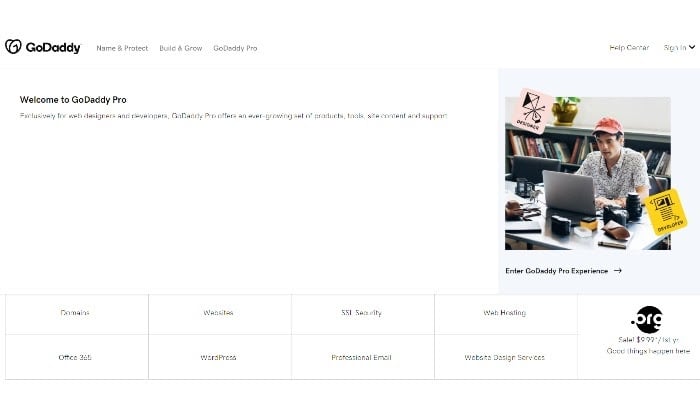
The GoDaddy Pro dashboard is where developers and resellers can manage client projects. A hub where you can manage all your tools, content, support, and discounts, as well as get in touch with GoDaddy support.
Since I’m recommending GoDaddy as a great host provider for beginners, the GoDaddy Pro dashboard might not be a necessary tool for you if you aren’t a webmaster or reseller. But it’s a free option if you’re interested in signing up for it. And it’s another way to get in touch with support.
The Best Cheap Web Hosting Provider
My team and I have created an in-depth review for the best cheap web hosting providers on the market you’ll want to read before making any real hosting decisions that you can see here. Here’s a quick recap:
- Hostinger — Best Web Hosting Plan Under $1
- Bluehost — The Best Value in Web Hosting
- A2 Hosting — The Best Customer Service
- HostGator — The Best Cheap Cloud Hosting
- iPage — Best Cheap Web Hosting Features
- GoDaddy — The Best Cheap Hosting for Beginners
Overall, GoDaddy is a great cheap hosting provider for beginner websites who’d like affordable VPS hosting, especially in their first year. It’s a more budget-conscious option than others out there, and it offers plenty of add-ons you can choose to include in your plan, so you’re never left without the hosting tools you need to succeed.
Once you’ve made up your mind on a hosting plan, you can get started with GoDaddy here.
The post GoDaddy Review appeared first on Neil Patel.
